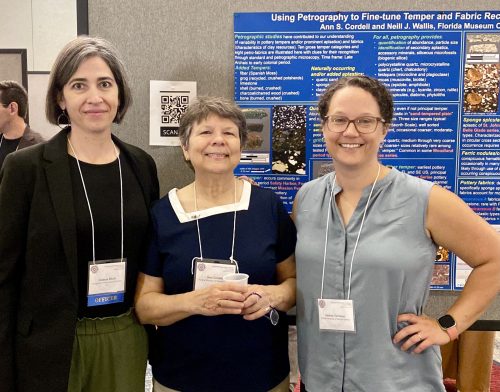As a junior scholar in the field and a new researcher in the US Southeast, I was thrilled to receive support from the FLMNH Directors Office and the Department of Natural History to attend my first Southeastern Archaeological Conference (SEAC) in Chattanooga, TN. My conference participation involved co-hosting a workshop with Neill Wallis about the Pan-American Ceramics Project (PACP)—an open-access web application designed to enhance the accessibility and reusability of ceramic data across all time periods from Canada to Argentina. As a crowd-sourced digital resource, the long-term success of the PACP requires widespread buy-in from a diverse community of international stakeholders. Prior to my arrival at the Florida Museum, I began mentoring several students on how to organize and enter ceramic type descriptions into the PACP database. Our primary foci have been the regions of West Mexico and US Southwest, but we have also taken advantage of the digitized type collections made available through the Ceramic Technology Lab website by my predecessor, Lindsay Bloch. This semester, with the help of FMUIP Intern Federica Amati, we have added more detailed descriptions of ceramic types belonging to the Weeden Island Series commonly found along the Gulf Coast of Florida.
The plan for our workshop at SEAC was to introduce attendees to the PACP’s current browsing capabilities, provide them with instruction on how to register and contribute data, and discuss future developments and areas for improvement. We also invited participants to bring their own dataset to begin uploading data on-site with our guidance. My hope was that this workshop would expand our current coverage of Southeastern pottery types within the PACP and provide opportunities for greater communication and collaboration between members of the Ceramic Technology Laboratory and other institutions. In reality, the workshop was poorly attended. I think this was due to it being scheduled at 8:00am on the same day that many conference attendees were eagerly anticipating a forum discussing the new image policy for the Southeastern Archaeology journal. Despite this outcome, I plan to return to SEAC in the future to host another workshop targeting the discussion and publication of a specific category of pottery, which will involve a set of invited participants rather than a general audience.
Overall, the time I spent at SEAC was worthwhile in other ways. I was able to re-connect with colleagues and introduce myself to others as the new Collections Manager of Florida Archaeology and Ceramic Technology Laboratory. As part of an ongoing NSF funded project on Pensacola shell-tempered pottery, Lindsay Bloch, Erin Nelson (University of South Alabama), Ashley Rutkoski (UF Anthropology PhD Student) and I had the opportunity to examine pottery from another repository that we brought back with us to the CTL for analysis. Attending the largest gathering of Southeastern archaeologists allowed me to learn about current research by listening to symposia and discussing posters with other attendees. Most importantly, it allowed Ann Cordell, Lindsay Bloch, and I to take a photo together during the session in which Ann was presenting a poster on the major contributions she has made to ceramic petrography in the US Southeast. I am honored to follow in their footsteps.
